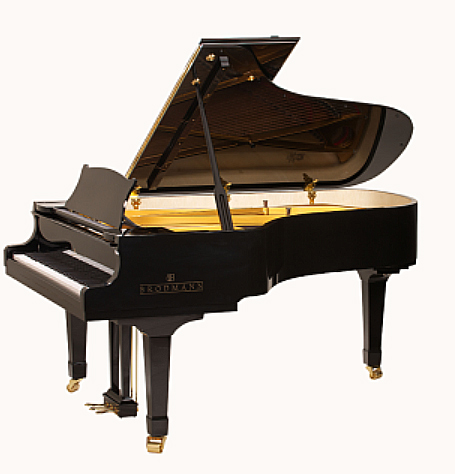Piano Tuning
What exactly
is piano tuning, and why is it important?

Unlike Hammond Organs and digital pianos and keyboards, pianos are mechanical instruments and as such they are subject to many physical phenomena that over time will effect their tuning. This of course is also true for almost all other musical instruments with the exception of traditional Hammond organs, which rely upon the frequency of the electric power that powers them, and electronic keyboards most of which depend for their tuning on the accurate high frequency oscillations of special crystals.
Pianos work by felt covered hammers hitting stretched steel wire strings. The tension on these strings determines their pitch; piano tuning involves adjusting the tension on each string so that all will vibrate at the correct frequencies. Over time, pianos generally will, if nothing is done about it, drop in pitch, as the cumulative force exerted by all of the strings in a modern piano is quite large, averaging around 20 tons. This is why you will always find heavy metal frames, referred to as "plates," in a piano in order to provide a structure that is rigid enough to withstand this force. In addition to the force of the tension on the strings, the pitch of a piano is also affected by temperature, and because the sound board and also the bridges, which are the structures over which strings pass in order to communicate their mechanical vibrations to the soundboard, are made of wood; humidity will minutely change the dimensions of these wooden parts and likewise exert a destabilizing influence on the pitch of the instrument.
In addition to the pitch of the entire instrument changing over time, the pitch of different regions of a piano can also change differently, thus we will find that if a piano is neglected, it will not only not be in tune with a pitch standard, but also it is possible for the piano to be out of tune with itself, as individual strings may change more or less than others. Therefore, periodically, a piano needs to be re-tuned to keep it sounding at its best.
At the very least, a piano should be tuned once a year so that it can be maintained at standard pitch. However, a piano should really be tuned twice a year to keep it sounding at its best and to prevent any minor seasonal discrepancies in tuning creep in and make it sound not quite as good as it should. If a piano is neglected for long periods of time (many years) so that it starts to drop noticeably below standard pitch, then the much more elaborate tuning procedure, known as "raising the pitch" must be done, and this can become very expensive. Often, if a piano has been allowed to drop considerably below standard pitch, the re-tuning must be done in stages to avoid making a sudden significant increase in tension to the structure of the piano. Also, when we consider how the strings pass over the bridges on the soundboard, and the fact that they bear down on the soundboard, when a tuner adds a significant amount of tension to go from as-found to back-in-tune, he will find that as he proceeds, the increasing tension will make strings already previously tuned drop somewhat in pitch and thus the tuning job becomes more complicated, generally requiring several visits by the tuner to restabilize the piano before he can do a final and accurate tuning.
At Main Street Music, we can provide accurate tuning and care for your piano by trained specialists who are very knowledgeable about all the nuances of piano construction and maintenance.
MAIN STREET MUSIC, LLC
719 Main Street
Waltham, MA 02451
(781) 893 6644, or find us on line at:
www.mainstreetmusicboston.com